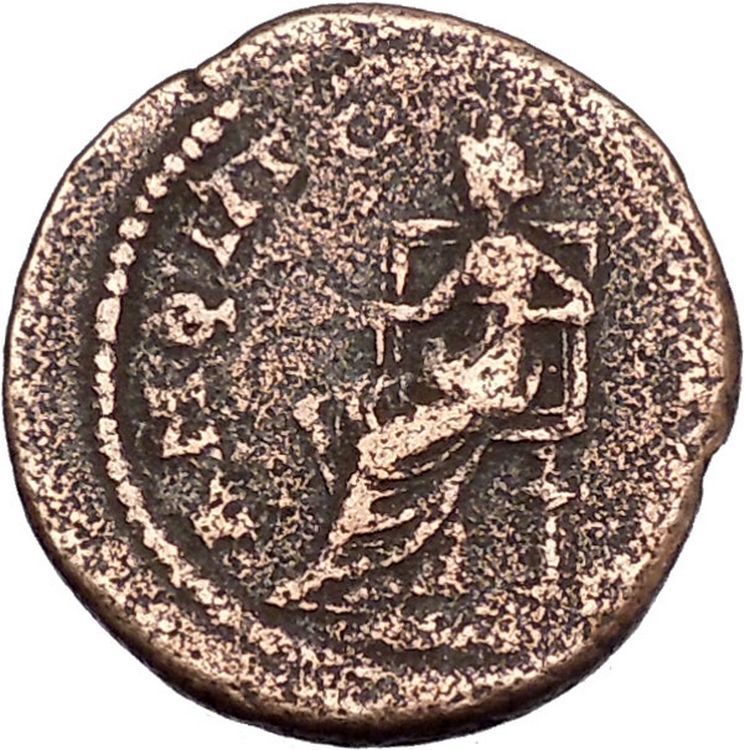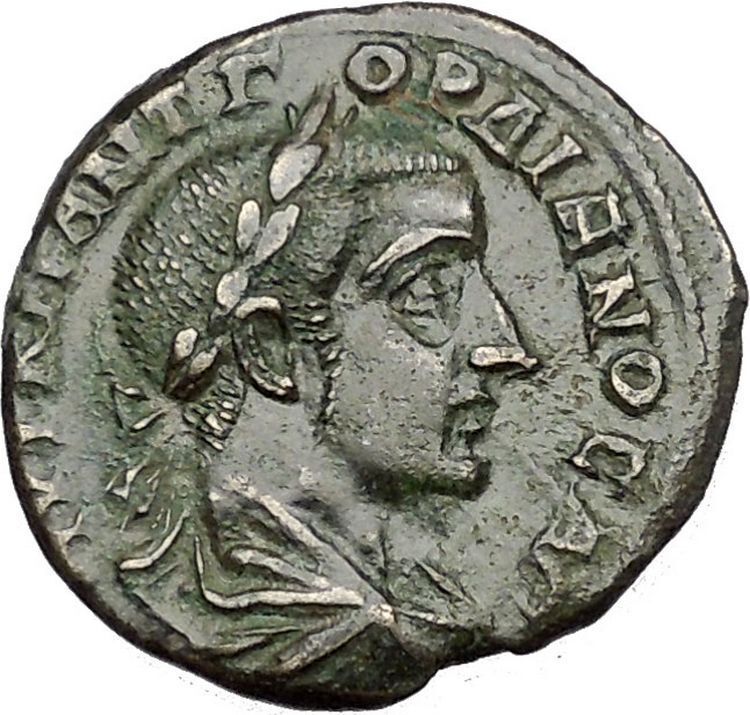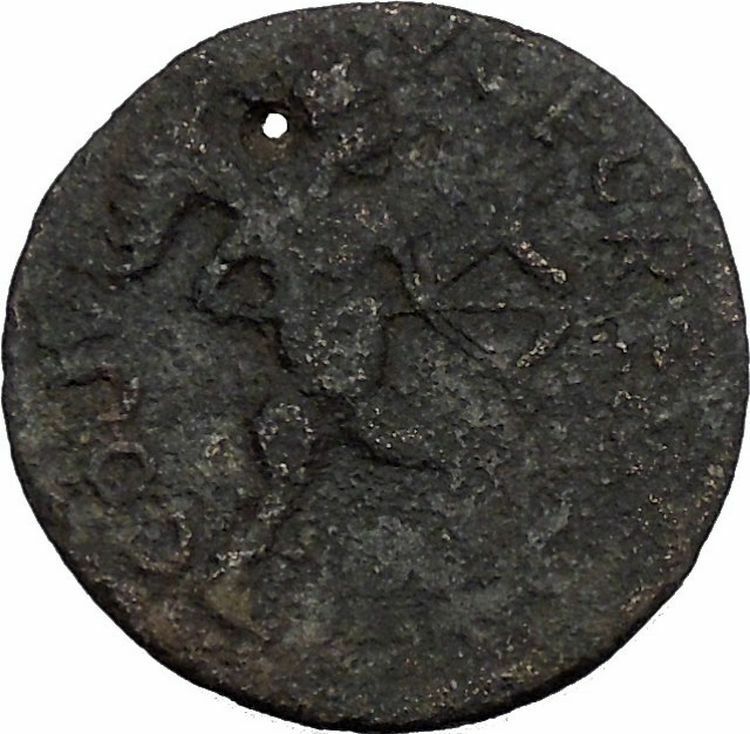|
Diadumenian – Roman Caesar: 218 A.D.
Bronze 20mm (4.74 grams) of Marcianopolis in Moesia Inferior
OΠEΛΛI ANTΩNINO, bare-headed draped and cuirassed bust right.
MAPKIANOΠOΛEITΩN, Asclepius, the god of medicine standing facing with his head turned left, leaning on the serpent-entwined medical symbol staff.
You are bidding on the exact item pictured, provided with a Certificate of Authenticity and Lifetime Guarantee of Authenticity.
.JPG/200px-Statue_of_Asklepios_NAMA_263_(DerHexer).JPG)  Asclepius is the god of medicine and healing in ancient Greek religion. Asclepius represents the healing aspect of the medical arts; his daughters are Hygieia (“Health”), Iaso (“Medicine”), Aceso (“Healing”), and Panacea (“Universal Remedy”). The rod of Asclepius, a snake-entwined staff, remains a symbol of medicine today, although sometimes the caduceus, or staff with two snakes, is mistakenly used instead. He was associated with the Roman/Etruscan god Vediovis. He was one of Apollo’s servants. Asclepius is the god of medicine and healing in ancient Greek religion. Asclepius represents the healing aspect of the medical arts; his daughters are Hygieia (“Health”), Iaso (“Medicine”), Aceso (“Healing”), and Panacea (“Universal Remedy”). The rod of Asclepius, a snake-entwined staff, remains a symbol of medicine today, although sometimes the caduceus, or staff with two snakes, is mistakenly used instead. He was associated with the Roman/Etruscan god Vediovis. He was one of Apollo’s servants.
The rod of Asclepius, also known as the asklepian, is an ancient symbol associated with astrology, the Greek god Asclepius and with medicine and healing. It consists of a serpent entwined around a staff. The name of the symbol derives from its early and widespread association with Asclepius, the son of Apollo, who was a practitioner of medicine in ancient Greek mythology. His attributes, the snake and the staff, sometimes depicted separately in antiquity, are combined in this symbol. The Rod of Asclepius also represents the constellation Ophiuchus (or Ophiuchus Serpentarius), the thirteenth sign of the sidereal zodiac. Hippocrates himself was a worshipper of Asclepius.
Marcianopolis, or Marcianople was an ancient Roman city in Thracia. It was located at the site of modern day Devnya, Bulgaria.
The city was so renamed by Emperor Trajan after his sister Ulpia Marciana, and was previously known as Parthenopolis. Romans repulsed a Gothic attack to this town in 267 (or 268), during the reign of Gallienus. Diocletian made it the capital of the Moesia Secunda province.
Valens made it his winter quarters in 368 and succeeding years, Emperor Justinian I restored and fortified it. In 587, it was sacked by the king of the Avars but at once retaken by the Romans. The Roman army quartered there in 596 before crossing the Danube to assault the Avars.
Between 893 and 972 it was one of the most important medieval cities in south-eastern Europe.
 Diadumenian – Roman Caesar: 218 A.D. Diadumenian – Roman Caesar: 218 A.D.
Son of Macrinus
Marcus Opellius Antoninus Diadumenianus or Diadumenian (208-218) was the son of the Roman Emperor Macrinus, and served his father briefly as Caesar (May 217-218) and as Augustus (in 218). Diadumenian was born in 14th of September 208 a.C or according to Historia Augusta in 19th of September 208 a.C because he shared the same birthday with the emperor Antoninus Pius. His mother was Empress Nonia Celsa, although her existence remains dubious, because she was only mentioned by the Historia Augusta. He was born Marcus Opellius Diadumenianus, but his name was changed and added Antoninus to solidify connection to the family of Marcus Aurelius as done by Caracalla.
Diadumenian had little time to enjoy his position or to learn anything from its opportunities because the legions of Syria revolted and declared Elagabalus ruler of the Roman Empire. When Macrinus was defeated on June 8, 218, at Antioch, Diadumenian followed his father’s death.
|





.JPG/200px-Statue_of_Asklepios_NAMA_263_(DerHexer).JPG)
 Asclepius is the god of medicine and healing in ancient Greek religion. Asclepius represents the healing aspect of the medical arts; his daughters are Hygieia (“Health”), Iaso (“Medicine”), Aceso (“Healing”), and Panacea (“Universal Remedy”). The rod of Asclepius, a snake-entwined staff, remains a symbol of medicine today, although sometimes the caduceus, or staff with two snakes, is mistakenly used instead. He was associated with the Roman/Etruscan god Vediovis. He was one of Apollo’s servants.
Asclepius is the god of medicine and healing in ancient Greek religion. Asclepius represents the healing aspect of the medical arts; his daughters are Hygieia (“Health”), Iaso (“Medicine”), Aceso (“Healing”), and Panacea (“Universal Remedy”). The rod of Asclepius, a snake-entwined staff, remains a symbol of medicine today, although sometimes the caduceus, or staff with two snakes, is mistakenly used instead. He was associated with the Roman/Etruscan god Vediovis. He was one of Apollo’s servants. Diadumenian – Roman Caesar: 218 A.D.
Diadumenian – Roman Caesar: 218 A.D.




